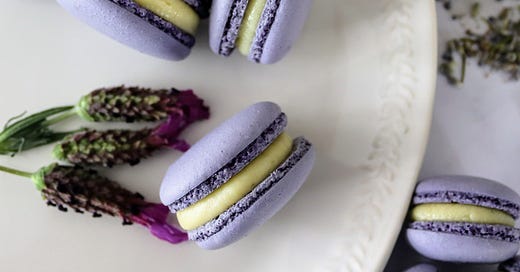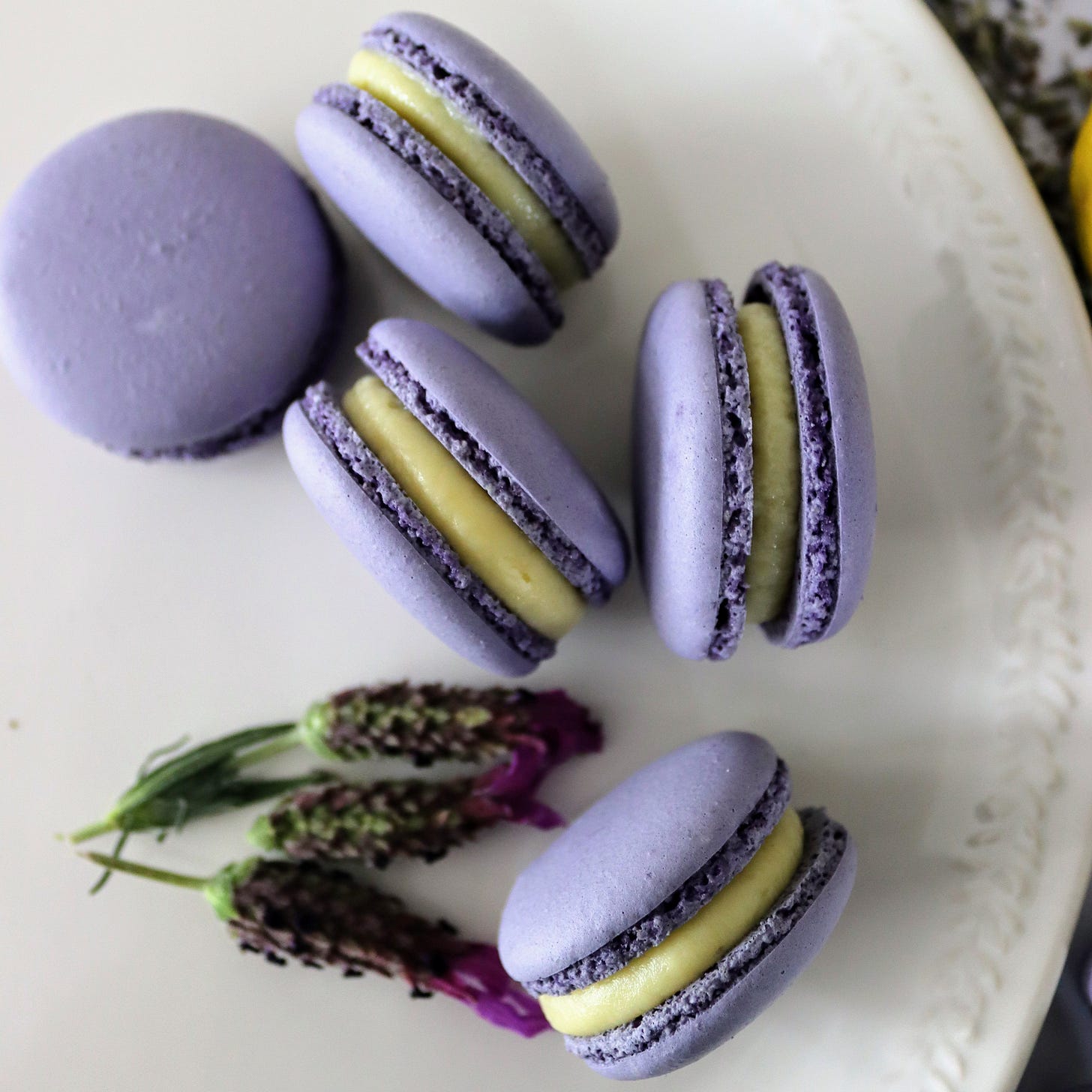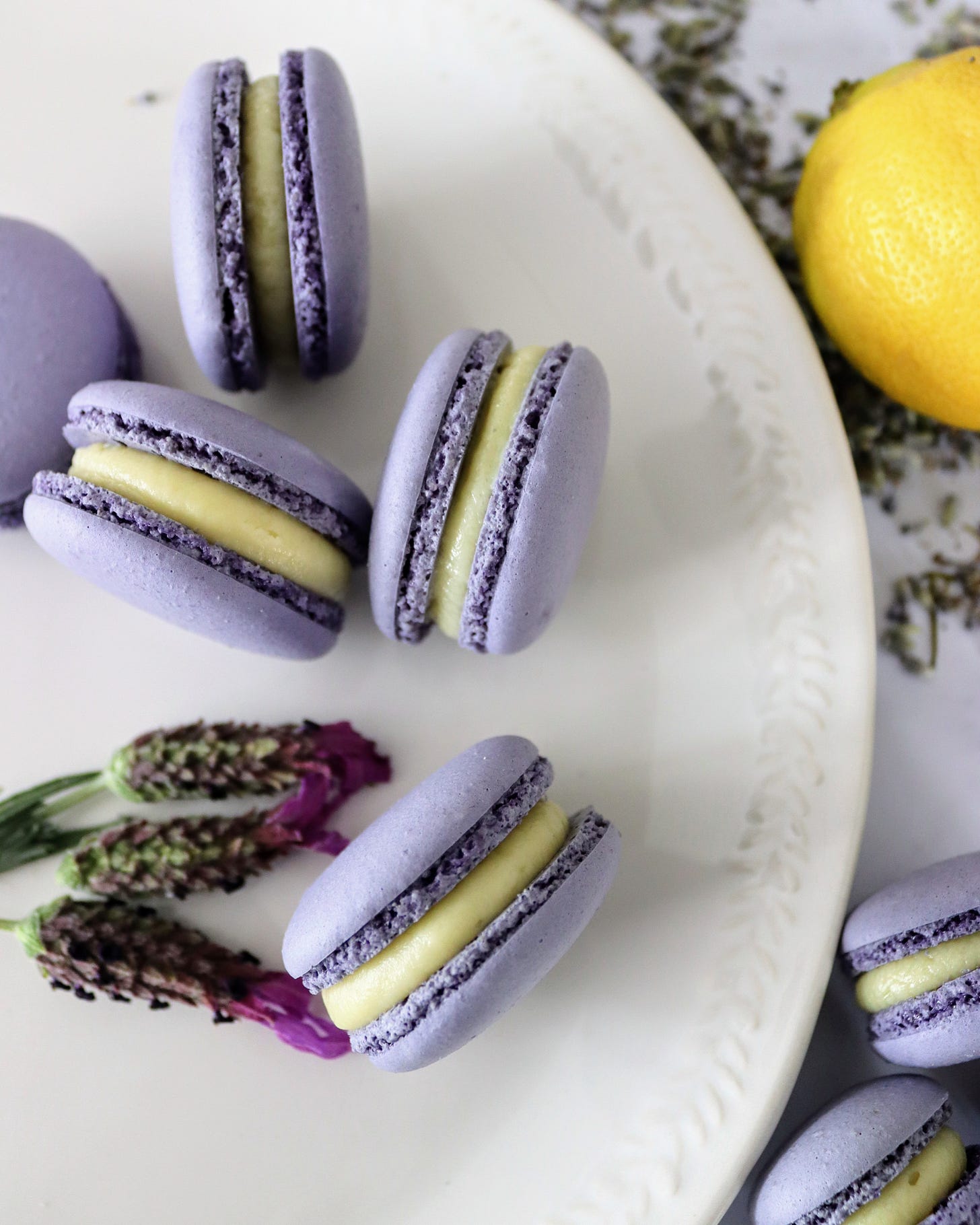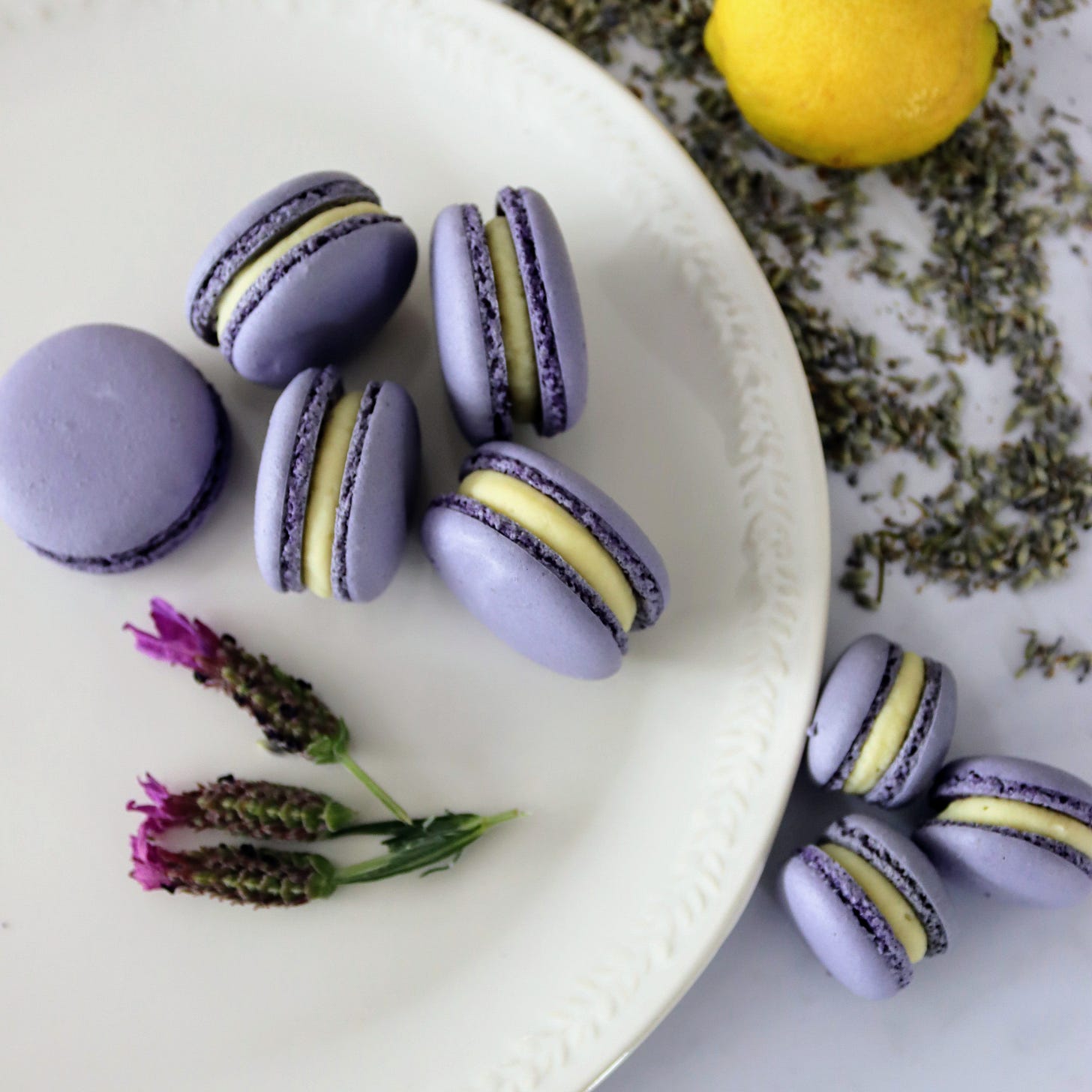Hello and welcome back to Bake Experiments - where we play with flavours and techniques. With a bit of baking history & folklore thrown in too.
Thank you so much for being here. I hope you enjoy this post. And if you like what you read? Please do subscribe, share or like. Thank you.❤️
Welcome to the forth edition of my ‘A love letter to…’ series. Where I show my love for, and experiment with, slightly more unusual flavour pairings, giving you fresh ideas for your bakes.
So far this year we have enjoyed Orange and Rosemary, Peach and Oregano and Apricot & Rose. I somehow missed a flavour pairing post in April, but I am excited to crack on with May’s combo of Lemon & Lavender.
Before we begin, the usual vote! I would be thrilled to hear what you’d like to investigate for next month’s love letter.
To Lemon & Lavender…
I will be blunt. Lavender, on your own, you kind of suck.
You may be having a moment, with your frothy purple Frappuccino in Starbucks. But for me, you can be a little bit of pretty lilac style over substance.
I shall explain. As a young woman, freshly in London and ready to enjoy the high life, I remember walking into a fancy bakery and setting eyes on the perfect purple swirls of a lavender cupcake.
It didn’t matter that it cost more than a fiver, it was a Friday evening and I was ready to enjoy something sweet and sophisticated.
Unfortunately, after I had parted ways with my hard earned cash… I discovered that it tasted disgusting. Like my mouth was being washed out with soap. I threw it away while making a funny scrunched up face. I didn’t go near lavender again for decades.
That is, until a fellow baker suggested I pair it with with lemon. (Oh, and honey too - but we’ll come back to that.)
Something about the sharp citrus of lemon helps balance out lavender’s floral notes, ensuring we don’t slide into soapy land. And conversely, lavender adds a gentle refinement to lemon.
There’s also that lovely alliteration going on too. Oooh, I love an alliteration.
History & Folklore
According to Masterclass, lavender has long been known for its powers of protection and preservation. The Egyptian’s used lavender oil as a perfume, and in mummification. The Greeks and Romans bathed in lavender infused water.
Clothing was stored in lavender and it was even scattered on church floors to ward off evil spirits. We know now that lavender has antibacterial properties.
It’s only in the middle ages that it started to be used in food and medicine. Since then, English lavender has become the most popular choice for culinary purposes, due to a mild floral flavour.
Lemons have their own mythology, so highly valued by the ancients they were included in the dowry of the Greek goddess Hera, wife of Zeus. She kept them hidden away in a garden at the far end of the earth.
In the 1800s, British physician James Lind discovered lemons could prevent scurvy, due to their high vitamin C content. Although shockingly, it took 50 years for them to become a staple on ships following his experiment.
How to bake with Lemon & Lavender
First up, when it comes to baking with lavender, make sure you choose culinary lavender buds.
I remember a work colleague excitedly bringing a lavender cake into work, baked with the lavender she had picked up from a market. I felt dreadful telling her it was best not to eat it, as she didn’t really know where the lavender had come from, and could be laden with all sorts of chemicals and pesticides.
Also, you don't want to be using fragrance buds meant for pot pourri.
The second rule of baking with lavender, is to use buds over extract.
A few words about lavender extract
If you are using extract? Be sure to use it SPARINGLY. OH MY GOSH. DO NOT USE VERY MUCH. THE FLAVOUR WILL INCREASE OVER TIME. YOU MUST USE IT VERY SPARINGLY.
Hopefully, that has hammered that point home.
For reference, for an entire large Bundt cake, you will probably only need 1/4 tsp of lavender extract.
It will also depend on the brand of lavender you are using, as some are stronger than others. A good rule of thumb is that you can always add a little more extract if the flavour isn’t strong enough. But you cannot take it away. So, build up slow.
I personally don’t use extract, as it’s so easy to go overboard and end up with a soapy cupcake situation. Instead, I prefer to infuse;
With sugar - Good Food recommends mixing 2 tsp of lavender bud to 1kg caster sugar. Perfect sprinkled on a lemon shortbread.
With honey - adding some lemon zest to this honey lavender tea cake by Amber Rose would be sublime.
For a savoury snack, Marcus Wareing suggests pairing lavender honey with crispy courgettes and lemony goat’s cheese.
With lemon curd - I found lemon curd can overpower the delicate floral lavender notes. Yet, the lavender does still brings a certain something. It’s a more refined, elegant tasting curd than straight lemon.
With butter - in Japanese cookbook Hokkaido, Tim Anderson includes a recipe for lavender butter. Apparently perfect with potatoes, or on toast.
Intrigued, I have attempted this with lemon and lavender. For me, while I loved the lemony tang to the butter, the lavender is a bit too strong here. But it is one I am keen to keep playing with.
In Lateral Cooking, Niki Segnit even tells us lavender can be infused in beurre blanc! An experiment I have not yet attempted, but will get back to you when I do. (I would love to hear if any of you brave souls tries it too.)
With milk or cream. In Domestic Goddess, Nigella Lawson uses lavender milk in the lavender variation of her classic cupcakes
However, it's infusing with cream that is my absolute favourite. The versatility here is spectacular. You can use this absolutely delicious cream to pour on fruity upside down cakes or crumbles, poached pears, bread pudding, as a base for a ganache or crème pat.
It is also perfect for anyone a bit nervous of lavender, as it gives you the opportunity to gradually increase the flavour profile and adapt to suit your personal taste buds. It may be a simple cream infusion, but I had to share it with you. Because I bloomin’ love it.
Lemon & Lavender cream
200ml double cream
Zest of a lemon
2 tsp lavender buds
2-4 tbsp caster sugar (depending on your sweetness preferences).
Place your lemon zest and lavender in a saucepan with your double cream.
Place on a medium high heat and let it slowly heat up. As soon as the cream starts to boil, whip it off the heat and cover with cling film, or a plate will do.
Leave it to infuse. The longer you leave it, the stronger the flavour. For me, twenty minutes is about right.
Sieve into a jug, before gently whisking in your sugar. I like to leave it in the fridge to thicken before serving.
Other flavours that could work well with Lemon & Lavender:
Honey!
Almonds
Pecans
Strawberries
Blueberries
Apricots
Peaches
Orange
Pears
Peaches
White & Milk Chocolate
Thyme (and lemon thyme)
Ginger
Herbs such as sage, rosemary and oregano. These herbs are all part of the mint family, along with lavender. Which is why the flavour profiles are complementary.
Other bake ideas with lemon & lavender:
Lemon Lavender Viennese Whirls, by Megan Cho
Lemon-Lavender Bread Pudding, by Jake Cohen
Ainsley Harriot’s Lemon Drizzle & Lavender Traybake (A British Chef I met about twenty years ago. He was really sweet, and from memory, obsessed with the buttons on my outfit.)
Lemon Posset, with blueberry lavender compote, by Jenny Irwin
And a sunshiney Lemon and Lavender Bundt by Martin Sorge
If you are already subscribed to Bake Experiments and are enjoying what you read, please consider upgrading to a PAID subscription - to support the experimentation and recipe testing behind this newsletter!
And have you heard about the Bake Experiments Recipe Index? An easily searchable one stop shop for all Bake Experiments recipes and experiments.
Whether you are looking for a light Springtime shortbread, to a fancy Autumnal Crumble Tartlet, this handy gallery is stuffed with recipe ideas and baking advice.
Lemon & Lavender Macarons
Aren't these pretty?! Remember the baker I mentioned, who suggested I pair lavender with lemon? She was suggesting a macaron flavour, and these are the result. I have sandwiched delightfully purple macaron shells with a lavender & lemon infused ganache.
Level: Advanced
Time taken: 2-3hrs hands on time, but overnight rests for the ganache and the finished macs.
Makes: Around 50 macaron shells (so 25 macarons)
Specialist equipment needed: a sugar thermometer, 3x silicone mats (versions with a macaron guide are helpful), stand mixer, piping bags and tips (I use Wilton 2A)
Ingredients
For the ganache
150g white chocolate (good quality)
75ml double cream
Zest of half a small lemon
1 tsp lavender buds
For the shells:
For the ‘paste’
150g ground almonds
150g icing sugar
55g egg white (I like to use a carton as they whip quicker, they are available in most supermarkets)
A knife tip of food colouring, I use Sugarflair Purple Extra
For the meringue
55g egg white
Half tsp cream of tartar
140g caster sugar
27g water
Your ganache:
Place your lemon zest and lavender in a saucepan with your double cream.
Place on a medium high heat and let it slowly heat up. As soon as the cream starts to boil, whip it off the heat and cover with cling film, or a plate will do.
Leave it to infuse. The longer you leave it, the stronger the flavour. For me, twenty minutes is about right.
Meanwhile, melt your white chocolate in short bursts in the microwave - no more than 30 seconds at a time. Stirring in between.
After infusing, you may need to heat your cream back up again. Once it is close to boiling, sieve it over your white chocolate.
Gently whisk it from the middle outwards, until it forms a perfect emulsion.
Cover with cling film, pressing down so it’s in contact with the ganache. We don’t want it to form a skin. Leave in the fridge overnight to set.
Your shells:
Begin with your almond paste. Sift your icing sugar and ground almonds into your mixer bowel and add your egg white. Whisk until well incorporated.
Transfer your paste to another bowl and cover.
Now, move on to your meringue. Clean up your whisk and mixer bowl.
Add your egg whites and cream of tartar and begin whisking at a low speed.
Place your water and 130g of caster sugar into a small pan. Keep aside 10g of sugar for later.
Put your saucepan on a medium high heat and cook. Do not stir it! You can swirl it round if you need to cover any sugar with the water.
With your sugar thermometer, test the syrup. Once it reaches 105°C, increase the speed of the mixer and add the remaining 10g of sugar. This will help stabilise the meringue.
When the sugar reaches 118°C - known as ‘softball’ stage, reduce the speed of your mixer and gently pour the sugar into the whisking egg whites.
Turn your mixer back up and mix for around ten minutes. Add your purple food colouring.
Once your meringue is velvety and thick, fold in your almond paste to make a ‘macaronage.’ I give my almond mixture a good mix to soften it first (it will have stiffened a bit as you make your meringue) before adding it to the meringue.
Then I follow the Le Corden Bleu technique: You make a slow circle in the mix and then strike through the middle, repeat this until you have the right consistency.
This is the hardest bit of macaron making. Undermix and you get big lumps of almond paste in your macarons, overmix and you get runny, flat macarons with spread feet. Just go slow, and if unsure, test it by placing a small amount on your silicone mat. You will see clearly if there are lumps and you need it to hold its shape relatively well. While it will spread a little, if it runs too much, you have over mixed.
At this stage, I like to rest the batter. Even for five minutes or so. I have noticed it helps ensure smooth macarons.
Grab your piping bag and tip and use a spatula to spoon in your macaronage. Don’t fill your bag up too much! The more you press on your macaron mixture, the higher the risk of an over mixed batter. I find it best to only half fill your bag and then refill as needed.
Pipe them onto a silicone mat, with your piping bag held up straight. Mats with a macaron guide are extremely useful. Or there are print out templates you can find online and place underneath your mats.
There are some great piping videos on youtube and I like this one from Shinee D.
Once you have piped, you need to ‘tap’ your macarons to get out any air bubbles. I find this hugely therapeutic. Pick up your tray and simply drop it onto the top. I tend to do this at least twice, ensuring I don’t go too hard so the macarons retain their circular shape. You can pop any final air bubbles with a toothpick.
Once piped, leave them to rest for around half an hour.
Once rested, bake at 130°C fan/266°F for 14-16 minutes. I only put one tray in per oven, as the bottom tray often cracks. If you only have the one oven, start a little conveyer belt with the first batch you piped going in first.
About five minutes into baking, rotate your tray.
Leave to cool before peeling off your silicone mats.
Filling
Take your ganache out of the fridge to come to room temp and a pipeable consistency.
Once ready, simply place in a piping bag with your Wilton 2A tip. Pipe a small dollop into the centre of your mac, leave a gap around the edge.
Press your macs together, et voila!
Cover them, and place back in the fridge overnight, so the macs can mature and take on the flavours.
Take them out of the fridge for around twenty minutes before enjoying. Filled macarons last around five days covered in the fridge.
Until next time…










Those macarons look absolutely amazing! Such good ideas throughout the whole piece for flavour pairings too - thank you.
These look absolutely stunning - the photos are beautiful! I also learnt the hard way that less is very much more when baking with lavender and it needs another relatively robust flavour alongside it, so lemon sounds perfect!